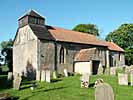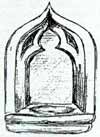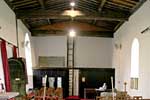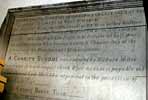 West Markham (Markham Clinton) West Markham (Markham Clinton)
All Saints
Features and Fittings
Click the numbers in the key plan for details of the items.
|
Key to Features and Fittings |
1 The South Door
 |
 |
The door is considered to be one of the oldest in the Diocese. It is set in a late Norman or Transitional doorway of plain ashlared stone. This predates the porch which was added in the 17th century. The door itself comprises three oak planks. They formerly had a low relief pattern carving on the outer face. Vestiges of this are just discernible in favourable light and there may have been a more extensive iron design on the door, leaving traces of raised wood and perhaps nail holes. Similar ‘ghost’ carvings are to be found on the north door of Southwell Minster. On the basis of the high rounded relieving arch and lower doorway on the inside, the rather tall narrow proportions of the relieving arch and the central strap it would appear that at least part of this door is early to mid-12th century. The two functional hinges may not be quite the same date as the central strap, but at least in style, with the split curl terminals, they are a Romanesque type. They definitely fit into the 'split-curl' type of design. The frame on the back is quite rough but full of character; the saltire cross brace is hard to date with accuracy as it occurs from the late 12th century to the end of the Middle Ages.
An old oak lock case with iron straps bolted onto the door leaf acts as a deadlock. The lockcase is a roughly formed section of timber containing the lock mechanism. The ironwork of the lock and bands is crude blacksmith's work. It is bolted to the door leaf with threaded square nuts which are probably of 18th or early 19th century date. A pull ring and latch is fixed on an oak plate above the lock case. The bracing and ledges on this are not original. The bracing, of re-used oak, halved at the cross junction. There are further re-used timbers in the porch roof. They have types of joint dating from the 17th century.
Thanks to Professor Jane Geddes of the University of Aberdeen for information on the door.
2Priest's Door
There is also a priest's door on the south wall leading to the chancel area, the doorway for which is 12th century.
3Font
The unusually carved tub font is Norman, and one of the church's most beautiful and significant features. It has been dated at no later than the last quarter of the 11th century. There are primitive carvings of saints (including those of the Virgin Mary holding baby Jesus, and St Ann holding a book) set within panels of crude, semicircular arcading. The figures are strikingly similar to the carving found on the gateway at Tickhill which almost certainly dates from c.1080. The lead lining was replaced in 1933. It is still used for baptisms.
4The Old Benches
In 1584 nine men were prosecuted for playing football in the churchyard. The game ended in a fight, one man being killed. The guilty were sentenced to make penance and undergo corporal punishment. One, a landowner, was allowed to commute his penalty to a fine, the money to “provide a seat in which parishioners might receive the sacrament secretly”. They are of a very simple construction of untreated oak. In 2012 they were placed alongside the walls at the rear of the church.
5Pulpit
 Pulpit Pulpit |
The wooden pulpit is Elizabethan.
6 Table
The table is Jacobean and was used post-Reformation as a communion table. The stone altar was at this time buried in the aisle.
7 Pillar Alms Box
 Alms Box Alms Box |
Believed to be Jacobean and contemporary with the chancel rail and the altar rail. Undated, but possibly the one recorded as being installed in 1719.
8 Carved Bosses
There are three carved bosses set in the nave roof. One is a ‘green man’. They were set in their present position in 1939 when many of the roof timbers were repaired or replaced. The timbers were from Clumber Park.
9 Carvings on the South Wall, Nave Window
 Salamanders Salamanders |
 Vines Vines |
These are ancient (exact date unknown, but possibly 13th century) and depict a salamander on one side and a vine on the other.
10 Pillar Piscina
Stone pillar and smaller stone capping. These are dated to the 12th century and of importance as pillar piscinae are uncommon.
11 Old Oak Chest
The exact age of this is unknown but it did contain the church registers and probably other items of value because it has crude iron fittings which would have been used to lock the chest.
12  Piscina Piscina
On the south wall by the altar and revealed during the 1930s renovations; ogee moulding, probably 14th century.
13Ladder
 Ladder at the Ladder at the
west end of the nave |
 Detail Detail |
Against the west wall of the nave is a ladder of some age, perhaps as early as 17th century.
14Benefactions Board
 Also on the west wall of the nave is an early 19th century benefactions board. Also on the west wall of the nave is an early 19th century benefactions board.
|